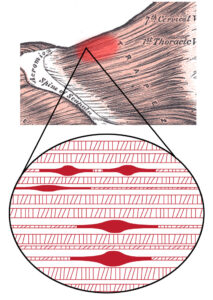What are Trigger Points?
 Trigger points are hyperirritable areas in the muscles or surrounding connective tissues that can cause pain, discomfort, and dysfunction. They are often referred to as «knots» in the muscles and can cause a range of symptoms, including local tenderness, stiffness, weakness, and referred pain to other areas of the body.
Trigger points are hyperirritable areas in the muscles or surrounding connective tissues that can cause pain, discomfort, and dysfunction. They are often referred to as «knots» in the muscles and can cause a range of symptoms, including local tenderness, stiffness, weakness, and referred pain to other areas of the body.
Trigger points can develop due to a variety of factors, including poor posture, overuse of muscles, trauma, and stress. They can also be caused by underlying medical conditions, such as fibromyalgia, myofascial pain syndrome, and chronic fatigue syndrome.
 Manual trigger point release involves applying pressure to the trigger point with fingers, knuckles, or elbows. This pressure can be applied using various techniques, such as sustained pressure, deep stroking, or circular friction. The goal of this technique is to help the muscle fibers relax and release the tension in the trigger point.
Manual trigger point release involves applying pressure to the trigger point with fingers, knuckles, or elbows. This pressure can be applied using various techniques, such as sustained pressure, deep stroking, or circular friction. The goal of this technique is to help the muscle fibers relax and release the tension in the trigger point.
How can I prevent getting trigger points?
Preventing trigger points can be challenging, but there are several strategies you can use to reduce your risk of developing them:
- Maintain good posture: Poor posture can put excess strain on your muscles and increase your risk of developing trigger points. Make sure to sit and stand with proper alignment, and take frequent breaks if you work in a sedentary job.
- Stretch regularly: Regular stretching can help to improve muscle flexibility and reduce tension, which can help to prevent trigger points from developing. Focus on stretching the muscles that are most prone to developing trigger points, such as the neck, shoulders, and lower back.
- Stay hydrated: Dehydration can cause muscles to become tight and irritable, which can increase the risk of developing trigger points. Make sure to drink plenty of water throughout the day to keep your muscles well-hydrated.
 Exercise regularly: Regular exercise can help to improve muscle strength and flexibility, which can reduce your risk of developing trigger points. Focus on exercises that target the muscles that are most prone to developing trigger points, such as the back, neck, and shoulders.
Exercise regularly: Regular exercise can help to improve muscle strength and flexibility, which can reduce your risk of developing trigger points. Focus on exercises that target the muscles that are most prone to developing trigger points, such as the back, neck, and shoulders.- Manage stress: Stress can cause muscles to become tense and irritable, which can increase the risk of developing trigger points. Make sure to manage your stress levels through techniques such as meditation, yoga, or deep breathing exercises.
- Get regular massages: Regular massage can help to reduce muscle tension and improve circulation, which can help to prevent trigger points from developing. Consider getting a massage once a month or more if you are prone to developing trigger points.
By following these strategies, you can reduce your risk of developing trigger points and maintain healthy, pain-free muscles.